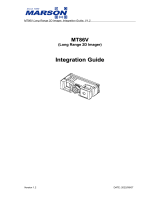
MT84G 2D Mini Scan Engine, Integration Guide, V0.5
TABLE OF CONTENTS
1
1.
.
I
IN
NT
TR
RO
OD
DU
UC
CT
TI
IO
ON
N ......................................................................................... 1
1-1. Block Diagram ................................................................................. 1
1
1-
-2
2.
.
E
El
le
ec
ct
tr
ri
ic
c
I
In
nt
te
er
rf
fa
ac
ce
e .............................................................................. 2
1
1-
-2
2-
-1
1.
.
P
Pi
in
n
A
As
ss
si
ig
gn
nm
me
en
nt
t ..................................................................... 2
1
1-
-2
2-
-2
2.
.
E
El
le
ec
ct
tr
ri
ic
c
C
Ch
ha
ar
ra
ac
ct
te
er
ri
is
st
ti
ic
cs
s ........................................................ 4
1
1-
-3
3.
.
O
Op
pe
er
ra
at
ti
io
on
na
al
l
T
Ti
im
mi
in
ng
g .......................................................................... 4
1
1-
-3
3-
-1
1.
.
P
Po
ow
we
er
r
U
Up
p ................................................................................ 4
1
1-
-3
3-
-2
2.
.
S
Sl
le
ee
ep
p
M
Mo
od
de
e ............................................................................ 4
1
1-
-3
3-
-3
3.
.
D
De
ec
co
od
de
e
T
Ti
im
mi
in
ng
g ....................................................................... 5
1
1-
-3
3-
-4
4.
.
S
Su
um
mm
ma
ar
ry
y
o
of
f
O
Op
pe
er
ra
at
ti
io
on
n
T
Ti
im
mi
in
ng
gs
s ........................................... 5
2
2.
.
S
SP
PE
EC
CI
IF
FI
IC
CA
AT
TI
IO
ON
NS
S ....................................................................................... 6
2
2-
-1
1.
.
I
In
nt
tr
ro
od
du
uc
ct
ti
io
on
n ...................................................................................... 6
2
2-
-2
2.
.
T
Te
ec
ch
hn
ni
ic
ca
al
l
S
Sp
pe
ec
ci
if
fi
ic
ca
at
ti
io
on
ns
s ................................................................. 6
2
2-
-3
3.
.
C
Co
on
nf
fi
ig
gu
ur
ra
at
ti
io
on
ns
s ................................................................................. 8
2
2-
-4
4.
.
I
In
nt
te
er
rf
fa
ac
ce
e ............................................................................................ 9
2
2-
-4
4-
-1
1.
.
U
UA
AR
RT
T
I
In
nt
te
er
rf
fa
ac
ce
e ...................................................................... 9
2
2-
-4
4-
-2
2.
.
U
US
SB
B
I
In
nt
te
er
rf
fa
ac
ce
e ......................................................................... 9
2
2-
-4
4-
-3
3.
.
U
US
SB
B
I
In
nt
te
er
rf
fa
ac
ce
e ....................................................................... 10
2-4. Operation Method .......................................................................... 10
2-4. Mechanical Dimension .................................................................. 11
2
2-
-5
5.
.
S
Sc
ca
an
nn
ni
in
ng
g
R
Ra
an
ng
ge
e ............................................................................ 12
2
2-
-5
5-
-1
1.
.
G
Gu
ua
ar
ra
an
nt
te
ee
ed
d
S
Sc
ca
an
nn
ni
in
ng
g
R
Ra
an
ng
ge
e ............................................. 12
2-6. Pitch Angle, Roll Angle and Skew Angle ..................................... 13
3
3.
.
I
IN
NS
ST
TA
AL
LL
LA
AT
TI
IO
ON
N ......................................................................................... 14
3
3-
-1
1.
.
E
El
le
ec
ct
tr
ro
os
st
ta
at
ti
ic
c
D
Di
is
sc
ch
ha
ar
rg
ge
e
C
Ca
au
ut
ti
io
on
ns
s ................................................. 14
3
3-
-2
2.
.
I
In
nt
te
eg
gr
ra
at
ti
io
on
n
a
an
nd
d
S
So
ol
ld
de
er
ri
in
ng
g ............................................................. 15
3-3. Window Materials .......................................................................... 16
3
3-
-4
4.
.
W
Wi
in
nd
do
ow
w
S
Sp
pe
ec
ci
if
fi
ic
ca
at
ti
io
on
ns
s .................................................................. 17
3
3-
-5
5.
.
W
Wi
in
nd
do
ow
w
C
Ca
ar
re
e .................................................................................. 19
4
4.
.
R
RE
EG
GU
UL
LA
AT
TI
IO
ON
NS
S ......................................................................................... 19
5
5.
.
D
DE
EV
VE
EL
LO
OP
PM
ME
EN
NT
T
K
KI
IT
T ................................................................................. 20
6
6.
.
S
SL
LE
EE
EP
P
M
MO
OD
DE
E ........................................................................................... 21
7
7.
.
P
PA
AR
RA
AM
ME
ET
TE
ER
R
S
SE
ET
TU
UP
P ................................................................................ 22
8
8.
.
V
VE
ER
RS
SI
IO
ON
N
H
HI
IS
ST
TO
OR
RY
Y .................................................................................. 23
























